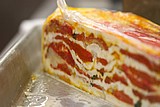Home |
Restaurants by City
|
Food Photography |
Archive | Philosophy |
![]()
Right now we are eating in Seattle, Washington.
|
Monday
2006
Permalink
|
A Week at the Culinary Institute of America (continued) - Cooking, Hyde Park, NY, tasted on December 19-22, 2005 We're finally back in the swing of things here at tastingmenu, and it's time to pick up where we left off recounting our week taking a class at the Culinary Institute of America (the C.I.A.). We've covered a variety of topics already including: the facilities, student life, and the lectures. Enough beating around the bush, it's time to get to some cooking, and in fact that's today's topic. Cooking in our spacious classroom kitchen. Actually, cooking was what we spent most of our time doing during the week (with eating a close second) so it's time we got to it. After lecture each morning we hit the kitchen. Our class was organized into 3-4 person teams. Each team had a series of dishes to prepare. We prepared the first round of dishes over days one and two, and the second round during days three and four. Some dishes or elements of dishes could be prepared a day in advance so it worked out. And this is a fine thing whether cooking for a couple of people, or cooking at a slightly larger scale (a dozen or two) like we were. In fact, scale is really the operative word when it comes to all the cooking we did. When it comes to food, scale is the enemy of great. A great dish is a living thing. Chemical reactions are happening especially when it comes to hot dishes. And each dish, each ingredient (even ice) has a window in which it's at its peak. Making a great dish is all about great timing. Making sure that all the ingredients come together when they are all at their peak. This is hard enough. Try doing it with multiple dishes for dozens (or hundreds) of people is an unbelievable challenge. And cooking professionally is much less about (in terms of energy spent) about creativity in cooking and ingredients than it is about what many companies call - program management. Program managing your dishes requires careful and thoughtful preparation. But it also requires creativity. What do you do when you've got dozens of people coming for a meal, you've got several more dishes to prepare, and a key piece of equipment is missing? You improvise. I needed a way to make sure the top on my Mozzarella, Roasted Tomato, and Prosciutto Terrine stayed depressed so the terrine set tightly. It was nothing that couldn't be fixed by some of the attachments for the industrial strength mixer that each weighed a ton. It's possible that someone in the afternoon session needed those mixing attachments and couldn't find them because they spent the night in the fridge keeping my terrine compressed. This is of course not the optimal way to operate as it can bite you in the ass as well. For example, on one of the days I had some extra chicken and decided to make some chicken soup. My father and I were having our regular debate about who makes a better chicken soup. (I do of course.) I put the soup in the fridge overnight so we could try it the next morning. The next morning I walk in to find it gone. I searched the entire place for it. No luck. I can't prove that our student teacher who showed up early that day to make lunch for the staff of the Continuing Education Office used it. But when I rolled in at 6:52am he already had the start of his paella going. Last I checked you need stock to make paella. I'm guessing a seafood stock would be best, but chicken wouldn't be the end of the world. And this particular student teacher, while super helpful and knowledgeable around the kitchen had an aversion to going down to the storeroom to get anything. I suppose an alternate possibility is that my soup was so damn good, the evening class ate it. Unfortunately this will remain a mystery. The main lesson that I took away was that I was on my own and had to worry about every detail of what I was doing. Nobody was going to look out for me, and in the most extreme cases other people's behavior might either purposefully or inadvertently really screw me if I wasn't careful. Luckily my soup was only something to prop up my ego and not something I needed to serve the dishes I'd committed to deliver. It was funny, each team got about 3-4 dishes to make each day over several hours. I've mentioned that the class is tough because people with all manner of skills come to the class with an even broader range of expectations. Luckily Chef DeShetler (Chef D) our instructor was cool with us taking on extra dishes. This is more complicated than it sounds as it involves getting the ingredients on short notice from the storeroom. But we managed.
What really matters of course is how the food we slaved over tasted. We'll get to that in the next post. :)
|
|||
Our Sponsors
Free Car Listings Hot Tubs Stools Saunas Bar Stools - Calendar and Event Schedules - Food Events and Calendars - Wine Events and Calendars - Digital Photography Resources - Software for Advertisers - Jewish Gifts and Judaica - Howard Stern Podcast - ponytailed blogger Jonathan Schwartz

Browse tastingmenu
Home |
Restaurants by City X |
Food Photography |
Archive | Philosophy |
![]()
Free eBooks: All About Apples
| Autumn Omakase
More:
Discussion |
Cool Food T-Shirts |
Ingredients
| Markets |
Recipes
Search |
Blog FAQ |
Other
Blogs
Best of tastingmenu
|
City View
Entry: July 6, 2006 |
Blue Plate
Entry: June 19, 2006 |
L'Atelier de Joël Robuchon
Entry: July 18, 2006 |
Browse by City
Boston | Chicago | Houston | Las Vegas | Los Angeles | Maui | New York | Philadelphia | Portland | San Francisco | Seattle | Toronto | Utah | Vancouver | Washington D.C.
Bangkok | Beijing | Hong Kong | Seoul | Tokyo
Amsterdam | Berlin | Italy | London | Madrid | Paris | Vienna
Browse by Month
2006
2005
2004
2003
2002
2001
Comments, questions, or feedback:
info / at / tastingmenu / dot / com
All pages Copyright (c) 2001-2006 tastingmenu.com
Last modified 01/30/07.





